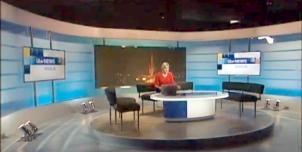Full Freeview on the Tacolneston (Norfolk, England) transmitter
| Google Streetview | Google map | Bing map | Google Earth | 52.518,1.139 or 52°31'6"N 1°8'22"E | NR16 1DW |
The symbol shows the location of the Tacolneston (Norfolk, England) transmitter which serves 330,000 homes. The bright green areas shown where the signal from this transmitter is strong, dark green areas are poorer signals. Those parts shown in yellow may have interference on the same frequency from other masts.
This transmitter has no current reported problems
The BBC and Digital UK report there are no faults or engineering work on the Tacolneston (Norfolk, England) transmitter._______
Digital television services are broadcast on a multiplexes (or Mux) where many stations occupy a single broadcast frequency, as shown below.
64QAM 8K 3/4 27.1Mb/s DVB-T MPEG2
DTG-12 QSPK 8K 3/4 8.0Mb/s DVB-T MPEG2
H/V: aerial position (horizontal or vertical)
Which Freeview channels does the Tacolneston transmitter broadcast?
If you have any kind of Freeview fault, follow this Freeview reset procedure first.Digital television services are broadcast on a multiplexes (or Mux) where many stations occupy a single broadcast frequency, as shown below.
64QAM 8K 3/4 27.1Mb/s DVB-T MPEG2
DTG-12 QSPK 8K 3/4 8.0Mb/s DVB-T MPEG2
H/V: aerial position (horizontal or vertical)
Which BBC and ITV regional news can I watch from the Tacolneston transmitter?

BBC Look East (East) 0.8m homes 3.2%
from Norwich NR2 1BH, 16km northeast (37°)
to BBC East region - 27 masts.
70% of BBC East (East) and BBC East (West) is shared output

ITV Anglia News 0.8m homes 3.2%
from NORWICH NR1 3JG, 16km northeast (38°)
to ITV Anglia (East) region - 26 masts.
All of lunch, weekend and 80% evening news is shared with Anglia (West)
Are there any self-help relays?
| Gt Yarmouth | Transposer | 1 km S town centre | 30 homes |
| Lowestoft (2) | Transposer | Rotterdam Rd | 125 homes |
How will the Tacolneston (Norfolk, England) transmission frequencies change over time?
| 1950s-80s | 1984-97 | 1997-98 | 1998-2011 | 2011-13 | 2013-18 | 2013-17 | 17 Jul 2018 | ||
| VHF | C/D E | C/D E | C/D E | E | E T | W T | W T | ||
| C3 | BBCtvwaves | ||||||||
| C31 | com7 | com7 | |||||||
| C32 | _local | ||||||||
| C37 | com8 | com8 | |||||||
| C39 | +ArqB | +ArqB | ArqB | ||||||
| C40 | BBCA | ||||||||
| C42 | SDN | SDN | SDN | SDN | |||||
| C43 | D3+4 | ||||||||
| C45 | ArqA | ArqA | ArqA | ArqA | |||||
| C46 | BBCB | ||||||||
| C50tv_off | BBCB | BBCB | |||||||
| C52tv_off | C5waves | C5waves | |||||||
| C55tv_off | BBC2waves | BBC2waves | BBC2waves | -BBCA | -BBCA | -BBCA | com7tv_off | ||
| C56tv_off | COM8tv_off | ||||||||
| C57tv_off | LNR | LNR | |||||||
| C59tv_off | ITVwaves | ITVwaves | ITVwaves | -D3+4 | -D3+4 | -D3+4 | |||
| C62 | BBC1waves | BBC1waves | BBC1waves | BBCB | |||||
| C65 | C4waves | C4waves | C4waves |
tv_off Being removed from Freeview (for 5G use) after November 2020 / June 2022 - more
Table shows multiplexes names see this article;
green background for transmission frequencies
Notes: + and - denote 166kHz offset; aerial group are shown as A B C/D E K W T
waves denotes analogue; digital switchover was 9 Nov 11 and 23 Nov 11.
How do the old analogue and currrent digital signal levels compare?
| Analogue 1-4 | 250kW | |
| SDN, ARQA, ARQB, BBCA, D3+4, BBCB | (-4dB) 100kW | |
| com7 | (-9.6dB) 27.4kW | |
| com8 | (-10.2dB) 24kW | |
| Mux 1*, Mux 2*, LNR | (-14dB) 10kW | |
| Mux A*, Mux B*, Mux C*, Mux D* | (-17dB) 5kW | |
| Analogue 5 | (-18dB) 4kW |
Local transmitter maps
Tacolneston Freeview Tacolneston DAB Tacolneston TV region BBC East Anglia (East micro region)Which companies have run the Channel 3 services in the Tacolneston transmitter area
|
|
Tuesday, 22 November 2016
T
Terry Hall 10:52 PM
jb38: I appear to have just responded to a post by you dated last Wednesday. I have only just come across it so it's no longer relevant so please ignore it. Apologies for any confusion.
| link to this comment |
Friday, 23 December 2016
T
Tristan11:38 AM
Why does the signalon ALL mux die almost every night between 1am and 2am??
| link to this comment |
S
StevensOnln112:13 PM
Tristan: You are most likely suffering from some form of local interference, probably caused by something in either your (or a neighbours) home operating on a timer switch.
| link to this comment |
Thursday, 29 December 2016
M
Mardler 9:10 PM
What happened to Tacolneston tonight?
Several channels on different mixes off air but not all.
Becoming all too common.
| link to this comment |
M
Mardler 9:39 PM
Annoying: no threading.
BBC CH Four blocky and dropping out.
Anyone here who really understands transmitter problems?
| link to this comment |
Friday, 30 December 2016
MikeP
4:11 PM
4:11 PM
Mardler:
For any contributor to this site to be able to offer any meaningful advice it is essential that you give a full post code. Only then can we determine the transmission and reception conditions local to your home.
| link to this comment |
H
hardy5:08 PM
High pressure weather affected Tacolneston reception in North Norfolk 29th. I suspect that the pressure enhanced the signal from the oxford transmitter which uses some of the same channels
| link to this comment |
Tuesday, 3 January 2017
R
Richard Cooper10:45 AM
hardy: Were you picking up BBC Oxford News and such like, then? Richard, Norwich.
| link to this comment |
Richard's: mapR's Freeview map terrainR's terrain plot wavesR's frequency data R's Freeview Detailed Coverage
H
hardy11:05 AM
no. The effect was like loss of signal on most channels . Worst on UHF channel 31 . affecting freeview 107 (BBC HDnews) etc . I suspect Oxford because it transmits half its multiplexes on the same UHF channels as Tacolneston at medium power. And is only about 20 degrees off Tacolneston in terms of bearing from central north Norfolk. In a couple of years time the plan is to move Tacolnestons channels away from Oxford
| link to this comment |
Sunday, 8 January 2017
M
Mardler4:22 PM
MikeP,
No need to give post code as I'm not asking about specific location.
If the transmission is dropping and/or s/s is low on only some channels it's the transmitter, atmospherics, nearby interference or user aerial system- in that order. In this case the problem was excellent s/s but zero quality so transmitter or (unlikely) atmospherics.
You guys always give the same answers: never the transmitter. In all my dealings with TV and radio reception transmitter faults have nearly always been the cause. Indeed, a couple of acquaintances were BBC transmission engineers and they said the same.
So, all I'm hoping to get is confirmation that others are having similar problems.
This site is a mine of information but it is terribly designed. For instance, why not use open source software to run a proper forum with threaded topics? I guarantee you will get better coverage immediately.
| link to this comment |
Select more comments
Your comment please!





